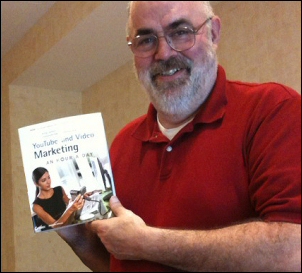 “Master Story Teller”, that’s how I would describe Greg Jarboe, someone I’ve known in the internet marketing and PR world for several years. Now he’s pioneered yet another essential digital marketing channel: online video. In YouTube and Video Marketing: An Hour A Day, Greg has assembled a priceless collection of insights, examples and practical tips for companies that want, that need, to understand how to use video marketing to grow their business. You cannot afford to miss this story.”
“Master Story Teller”, that’s how I would describe Greg Jarboe, someone I’ve known in the internet marketing and PR world for several years. Now he’s pioneered yet another essential digital marketing channel: online video. In YouTube and Video Marketing: An Hour A Day, Greg has assembled a priceless collection of insights, examples and practical tips for companies that want, that need, to understand how to use video marketing to grow their business. You cannot afford to miss this story.”
That’s the endorsement I gave Greg’s new book based on the preview copy a few months ago. He gave me a copy of the final book at SES and I thought it very timely to provide a more in-depth review.
Speaking of Greg Jarboe and videos on YouTube, here’s a video interview I did with Greg in 2006 at Pubcon where he offers excellent advice on staying current: “Use last year’s tactics and you’ll get last year’s results”. Search YouTube for Greg’s name and you’ll find he’s equally at home in front of and behind the camera.
As an active participant in the marketing industry, I see a lot of companies trying to get their arms around what will be the “next big thing” in digital marketing and social media. With YouTube the second most popular search engine after Google, video marketing is a big part of that answer.
What’s great about the “An Hour A Day” series from Wiley is that each book is structured around practical tips. Sure, there’s mention of a dead terrorist Ventriloquist dummy and Paris Hilton in jail, but you’ll also find great background information on the emergence of YouTube as the dominant online video hosting service on the front end and “Mysteries of Online Video Revealed” on the back end. In between, chapters 3-10 offer a day by day, week by week plan for developing and executing a video marketing effort over 8 months that any motivated marketer can follow.
The “guts” of the practical tips in this book start with mapping out a video marketing strategy, finding influencers on YouTube and other video services and a clever reversal of the “old map of mass media”. You’ll also find very specific video optimization tips starting with keyword research and tools as well as specific video optimization tips for YouTube, other video sites and types of video promotion.
Here are a few sample video optimization tips:
- YouTube SEO involves including keywords in the title, description and tags. Attracting views and ratings is also helpful for better rankings on YouTube.
- Web video SEO involves using keywords on the page the video is embedded in as well as in anchor text links to the page. Filenames, metadata and RSS enclosures are also opportunities for keyword inclusion.
You’ll find many more tips on video marketing besides those focused on SEO. The video marketing plan outlined in Jarboe’s book continues with tips on creating viral video content using an ample number of specific examples and then covers the brass tacks of creating a YouTube channel and socializing within the YouTube community.
While a lot of the popular videos on the web are of the home grown, Flip video type, there’s a lot to be said for good video production skills and chapter 6 covers everything from video formats to ideal resolution to editing software. Jarboe also offers advice on becoming a YouTube partner and advertiser before getting into the metrics of YouTube Insight (Trust but Verify) and illustrating the measurement of outcomes vs outputs.
In the way that Andrew Goodman “wrote the book” on Google AdWords, Greg Jarboe is undoubtedly the guy who “wrote the book” on YouTube and Video Marketing. If video is in your social media and content marketing future, this book is an excellent starting point.


